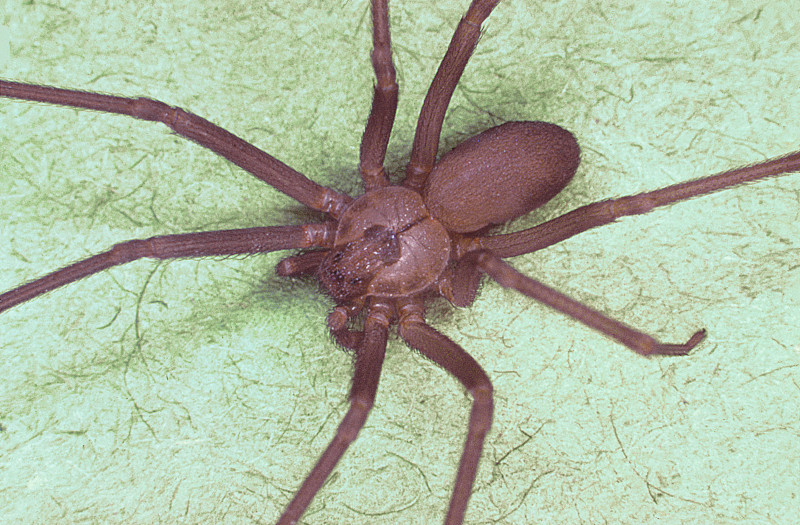Brown Recluse Spider Facts
- This seemingly harmless arachnid remains best known as the Brown Recluse Spider. The surprising arthropod also goes by several other common names, though. These terms include the brown fiddler, the violin spider, and the fiddleback spider.
- Among professional researchers, however, it’s generally referred to by the difficult to pronounce scientific name of the Loxosceles reclusa. But, which name one uses to refer to it fails to alter one simple fact. Its relatively benign appearance is quite misleading.
- In point of fact, this particular arachnid typically makes most top 10 lists of the most dangerous spiders in the world. Also impressive remains another fact. Such a great potential threat actually comes packaged in a comparatively small body.
- Fortunately, though, encounters with humans that end in bites rarely occur. This primarily occurs due to a combination of its reclusive nature, and its choice of preferred habitat. Yet, when bites are inflicted, these can be extremely serious in nature.
- For the moment, the IUCN does not presently have a classification for the Brown Recluse Spider. That’s due to the combination of adequate range and sufficient numbers. Any ranking would appear on the organization’s published Red List.
- It must, however, be considered to be at some potential risk, like many species today. Also like other creatures, it currently faces many threats. Further sharing mutual perils, its greatest dangers most likely consist of habitat loss and the effects of climate change.
Related Articles
Brown Recluse Spider Physical Description
While the magnificent Brown Recluse Spider impresses, it does not do so due to sheer size. Although certainly not the smallest known spider, by any means, it’s nevertheless tinier than most dangerous ones. Plus, it does display sexual dimorphism, but not in terms of size.
Somewhat oddly, adults vary significantly in size. As a result, leg spans average from 0.24 – 0.79 in (6 – 20 mm). Exceptional specimens do sometimes occur, however. That being said, unconfirmed reports of individual specimens approaching 1 in (2.5 cm) in span exist.
The color pattern of both genders also typically consists of a light or medium brown over the entire body. Some Brown Recluse Spider specimens display an off white, dark brown, or grayish color. Many display a black line on the side, and a violin-shaped marking.
The gender-based difference displays in the pedipalps. These leg-like structures are larger on the end among males. In appearance, though, its most notable feature remains its eyes. This spider has six eyes, instead of eight, arranged in pairs. Few spiders share this trait.
- Kingdom: Animalia
- Phylum: Arthropoda
- Class: Arachnida
- Order: Araneae
- Family: Sicariidae
- Genus: Loxosceles
- Species: L. reclusa
Brown Recluse Spider Distribution, Habitat, and Ecology
The often overlooked Brown Recluse Spider also holds yet another notable status. That’s the fact that this shy but potentially deadly spider only appears in a restricted portion of the world. In fact, that natural range consists of portions of the United States, in North America.
More precisely, its official native range covers much of the southeastern, southwestern, and parts of the mid-west regions. This area includes all or portions of 16 different states. But, perhaps due to the activities of humans, reports of sightings in other areas exist.
Within this zone, its natural habitat consists of such places as fallen logs. It further prefers dark, dry, undisturbed locations. It has also adapted to the presence of humans in its range. As a result, it frequently inhabits wood piles, garages, basements, and storage sheds.
The Brown Recluse Spider builds an irregular-shaped web. This also generally holds a small shelter. This particular variety of web weaver also differs from its brethren its behavioral patterns. It leaves its lair at night to hunt, with females tending to remain in closer proximity.
Given that it actively hunts and stalks its prey, it evolved to move quickly. Such prey usually includes creatures such as various small insects and even other small spiders. It’s also extremely resilient. In point of fact, individuals can survive for months between feedings.
Species Sharing Its Range
Check out our other articles on 4 Extraordinary Freshwater Fish, Chamois, Hogenakkal Falls, Himalayan Blue Poppy, Black-and-white hawk-eagle, Violet Carpenter Bee, Plumed Basilisk

